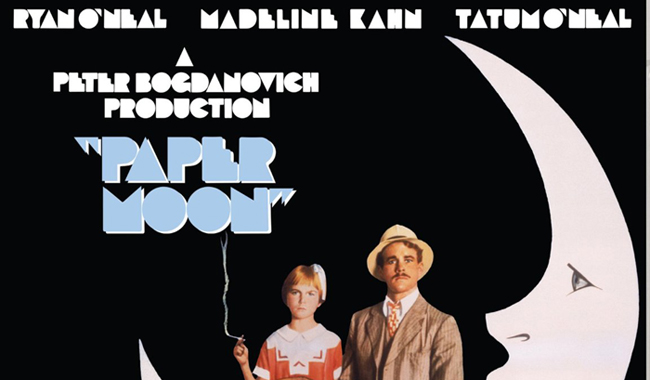
Paper Moon Review
 As Peter Bogdanovich says on one of the mini-documentaries accompanying the disc, “everything about this film is 1935 but with 1970s actors”. He’s not wrong there. The director has really honed his craft here. Bogdanovich was one of the so-called wunderkind director’s that came out of the social change and shift in post studio system Hollywood in that he referenced or paid homage to classical cinema. His first film, Targets (1968) was about a retired horror film star played by Boris Karloff who confronts a sniper and includes plenty of clips from classic Karloff pictures; The Last Picture Show (1971) was the film Bogdanovich made prior to Paper Moon about bored inhabitants of a small dust strewn Texas town in the 1950s. All these films are in black and white and are both modern and classic – Postmodern cinema is born if that doesn’t sound too pretentious.
As Peter Bogdanovich says on one of the mini-documentaries accompanying the disc, “everything about this film is 1935 but with 1970s actors”. He’s not wrong there. The director has really honed his craft here. Bogdanovich was one of the so-called wunderkind director’s that came out of the social change and shift in post studio system Hollywood in that he referenced or paid homage to classical cinema. His first film, Targets (1968) was about a retired horror film star played by Boris Karloff who confronts a sniper and includes plenty of clips from classic Karloff pictures; The Last Picture Show (1971) was the film Bogdanovich made prior to Paper Moon about bored inhabitants of a small dust strewn Texas town in the 1950s. All these films are in black and white and are both modern and classic – Postmodern cinema is born if that doesn’t sound too pretentious.
Paper Moon is based off a novel called ‘Addie Pray’ by Joe David Brown and at first the director was not enthused by the project but on speaking to friend Orson Welles he started to approach the project differently (when he went to Welles with the proposed new title for the film, ‘Paper Moon’ Welles enthusiastically said that he should “release the title even without the film”) and began in earnest. The location of the film was changed from the novel’s original location of the Deep South (so done) to the flatlands of Kansas and Missouri. The location works so intrinsically well with the film. Bogdanovich uses celebrated cinematographer Laszlo Kovacs to film (between him and fellow Hungarian dissident Vilmos Zsigmond they probably shot the most famous films of the late 60s and 1970s). Kovacs uses deep focus on the entire film meaning that the distance is as in focus as the foreground. There is a lot of use of this, particularly given the amount of distance there is in the flat Kansas landscape. In addition another suggestion made by Orson Welles was that even though it is shot in black and white a red filter was use over the lights thereby washing out the blues of the sky and giving an overall chalky look thereby ageing it. And although Bogdanovich places his film and its look in the era of an America just coming out of the Depression, the close-up photography, deep focus and technique are modern. This gives the film an air of authenticity and could explain why it never seems to have aged, “like a ready-shrinked shirt” as the director stated.
But what of the film itself? The story opens a little after that in the book at the lonely graveside of 11-year-old Addie’s (Tatum O’Neal) mother with drifting confidence trickster Moses Pray (Ryan O’Neal) tuning up at the small gathering. One of Addie’s Aunt’s suggest that Moses take Addy on a roadtrip to another Aunt who can look after her in Saint Joseph, Missouri which he eventually does so, albeit reluctantly, but not without realising that he can make a quick buck out of Addie’s misfortune. Aunts at the graveside are quick to remark that Addie and Moses have the same chin. Even though we strongly suspect that Addie is Moses’ daughter this is never explicitly admitted. That we already know that Ryan and Tatum are real life father and daughter helps drive this. There also becomes a genetic disposition in sharply conning people out of their money as they travel across the Badlands conning people out of money as they sell Bible’s to recently deceased widows and widowers by looking in the local obituaries.
The film almost took on immediate classic status and earnt young Tatum her first deserved Academy Award in her first film – still today she is the youngest person to win an Oscar. Any number of the cast and crew could have and should have won an Oscar including Kovacs stunning cinematography, Bogdanovich’s direction or Madeline Kahn funny as Moses’ brassy floozy. Released by Eureka! in their Masters of Cinema series the film is typically nicely packaged with three short documentaries about the making of the film covering the films conception through to its release and with a thorough 36-page booklet. On the cover is the iconic poster for the film that cleverly does not reveal the meaning of the title (beyond the popular contemporary tune) until near the end.
Chris Hick
